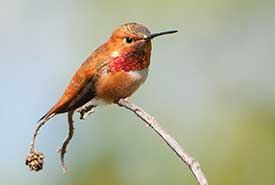
Rufous hummingbird (Photo by Stuart Clarke)
Rufous hummingbird
The rufous hummingbird is known for its beauty and its boldness. It’s an aggressive species by nature, and you will certainly notice its eye-catching, orange plumage as it is battles for the best feeding spot at your hummingbird feeder.
What does the rufous hummingbird look like?
Measuring up to 10 centimeters in length, the mature male rufous hummingbird is coloured with orange on its entire body, from head to tail. Beneath its long, needle-like beak is an iridescent-red throat and a white patch on its chest. The female’s colouring is dimmer in comparison; her plumage is generally green and brown with a slight hint of orange. The female’s throat is iridescent with green dots against a white backdrop. Some females have an eye-catching orange patch on their throat.
Where does the rufous hummingbird live?
The rufous hummingbird’s range encompasses Mexico, the United States and Canada. Similar to other birds that breed in Canada, the rufous hummingbird migrates to the southern U.S. and Mexico.
During breeding season, the male typically arrives first to the forests and meadows of northwestern U.S. and southwestern Canada. The female follows soon after to begin the nesting process. In Canada, their breeding grounds encompass southern Yukon, British Columbia and western Alberta.
To reach their wintering location in the southern U.S. and Mexico, the species will temporarily reside in mountain meadows that are located up to 3,800 metres in elevation. Once they arrive at their wintering grounds, they can be found in oak, pine and juniper woods.
What does the rufous hummingbird eat?
Like many hummingbirds, the rufous hummingbird not only consumes nectar from flowers, but also preys upon insects to load up on protein and fat. They tend to prefer colourful, tubular flowers like scarlet gilia and mint.
When collecting nectar from flowers, the rufous hummingbird is also spreading pollen and assisting in flower pollination.
What is the rufous hummingbird's conservation status?
Although the rufous hummingbird has not been assessed by the Committee on the Status of Endangered Wildlife in Canada, the population is estimated to have declined by over 60 per cent since 1966. In August 2018, the International Union for Conservation of Nature assessed the status of the global population of rufous hummingbird to be near threatened due to its rapid decline.
The rufous hummingbird’s decline is probably the result of a combination of threats, including habitat loss and climate change. Many hummingbird species — whose diet depends on the high-energy nectar of flowers — usually arrive at their breeding grounds when there are enough food sources. If the flowers bloom too early, it may not be able to sync its arrival with the full bloom.
Want to help?
Many Nature Conservancy of Canada (NCC) conservation areas across British Columbia provide habitat for rufous hummingbird during breeding season, such as the Chase Woods Nature Preserve, Dutch Creek Hoodoos, Sage and Sparrow Conservation Area and Mount Broadwood.





